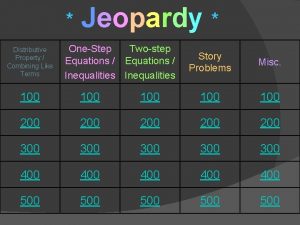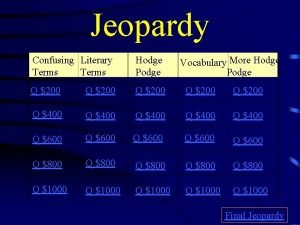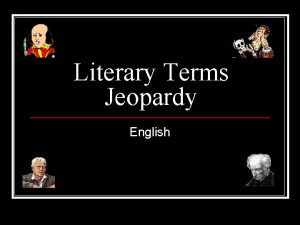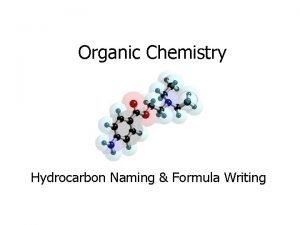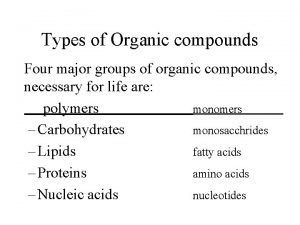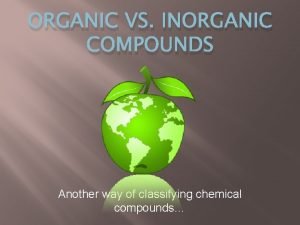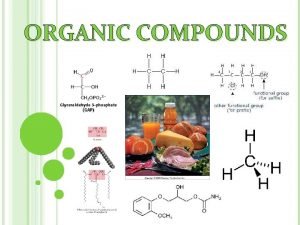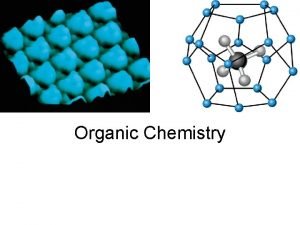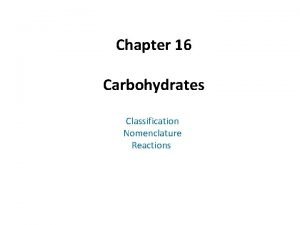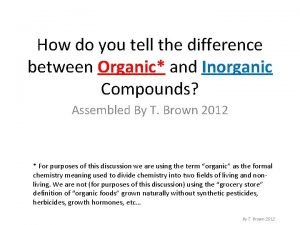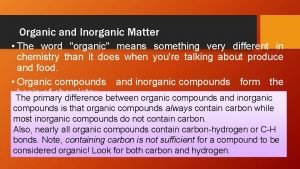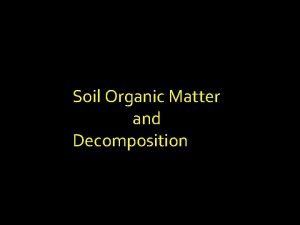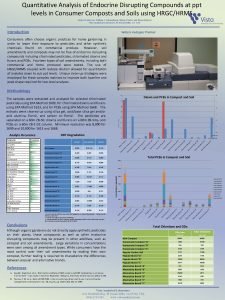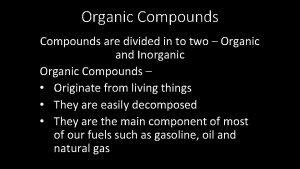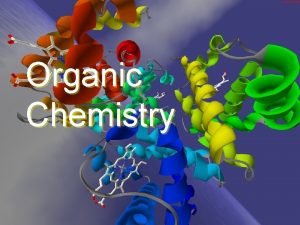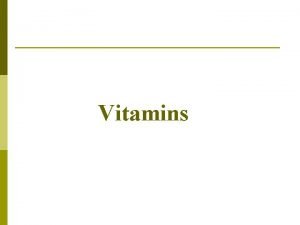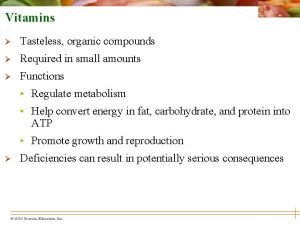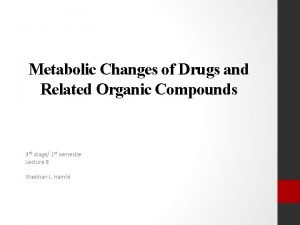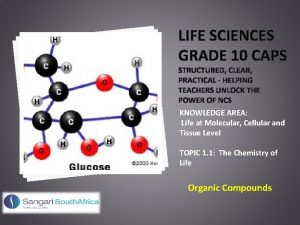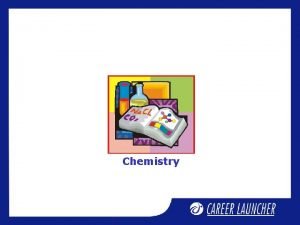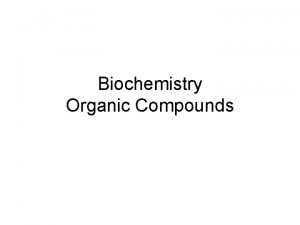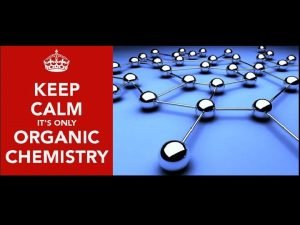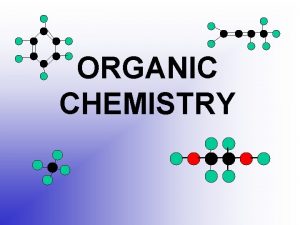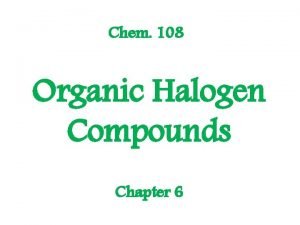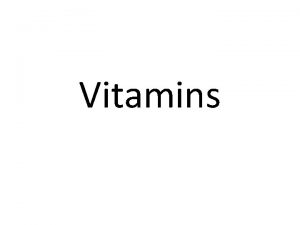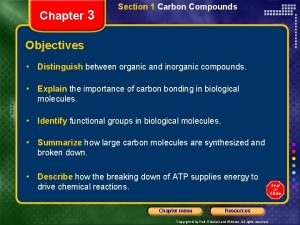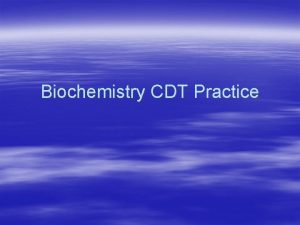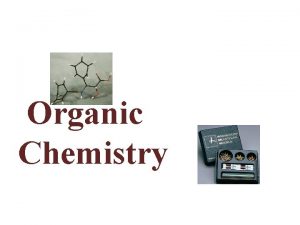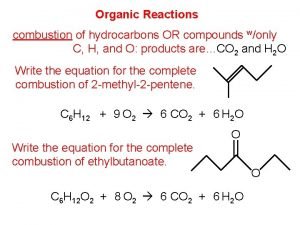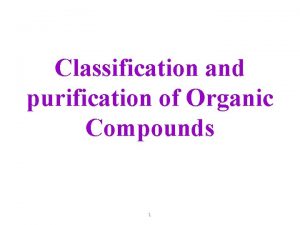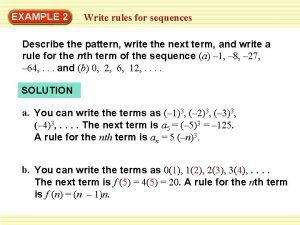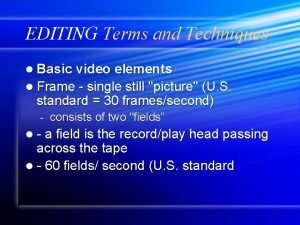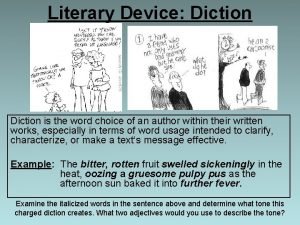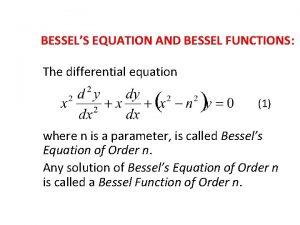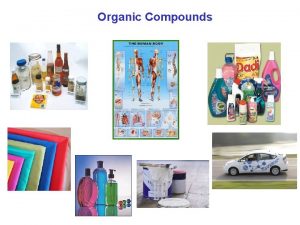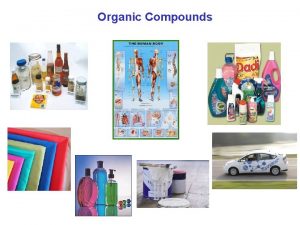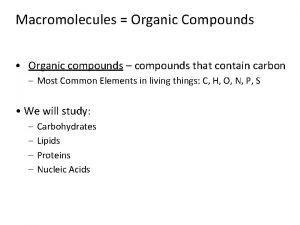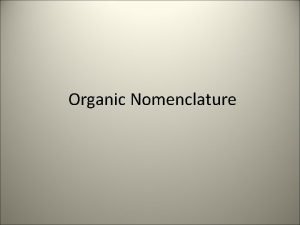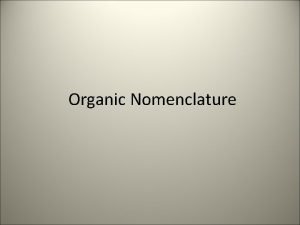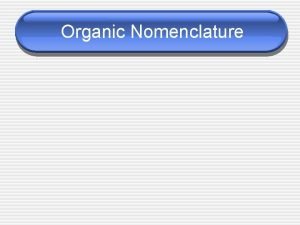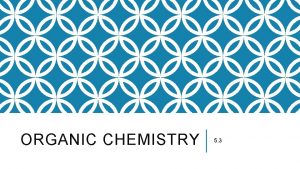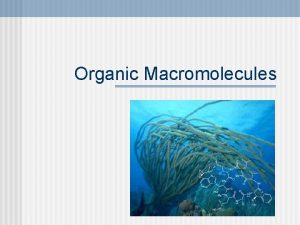terms Jeopardy Organic compounds Organic Compounds Organic compounds





















































- Slides: 53

terms Jeopardy Organic compounds Organic Compounds Organic compounds continued Flashback to chemistry Q $100 Q $100 Q $200 Q $200 Q $300 Q $300 Q $400 Q $400 Q $500 Q $500 Final Jeopardy

$100 Question from H 1 smallest unit of matter that cannot be broken down by ordinary chemical means

$100 Answer from H 1 What is: Atom

$200 Question from H 1 Atoms of an element that have a different number of neutrons

$200 Answer from H 1 What is: isotope

$300 Question from H 1 Bond formed by sharing electrons

$300 Answer from H 1 What is: covalent bonding

$400 Question from H 1 Define a compound

$400 Answer from H 1 Composed of 2 or more elements that are chemically combined

$500 Question from H 1 What is the difference between a monomer and a polymer? Provide an example of each

$500 Answer from H 1 Monomers are single units. Polymers are made of many monomers. Example: Monomer: nucleotide Polymer: DNA

$100 Question from H 2 Lipids are composed of

$100 Answer from H 2 What is: glycerol and 3 fatty acids

$200 Question from H 2 • What is the function of a carbohydrate?

$200 Answer from H 2 What is: quick source of energy

$300 Question from H 2 Amino acids are monomers of

$300 Answer from H 2 What is: protein

$400 Question from H 2 Why are enzymes important?

$400 Answer from H 2 What is: help mediate chemical reactions in body (ex: function in digestion)

$500 Question from H 2 What is the difference between carbohydrate, protein, lipids, and nucleic acids in terms of the elements that they contain?

$500 Answer from H 2 Carbohydrate: Carbon, hydrogen, oxygen Lipids: carbon and hydrogen Proteins: carbon hydrogen, oxygen, and nitrogen Nucleic acids: carbon, oxygen, hydrogen, nitrogen, phosphorous

$100 Question from H 3 What are the four organic compounds?

$100 Answer from H 3 What are: carbohydrates, proteins, lipids And nucleic acids

$200 Question from H 3 Distinguish between monosaccharide, Disaccharide, and polysaccharide

$200 Answer from H 3 What is: • monosaccharide 1 sugar • Disaccharide 2 sugars • Polysaccharide many sugars

$300 Question from H 3 The monomer that makes up the polysaccharide Starch is:

$300 Answer from H 3 What is: glucose

$400 Question from H 3 What is the chemical formula for this organic molecule? Hint Count the atoms of each element

$400 Answer from H 3 What is: C 6 H 12 O 6

$500 Question from H 3 What is the difference between saturated And unsaturated fats?

$500 Answer from H 3 What are: Saturated fat: single bond between carbons Unsaturated fats: double bonds between carbons

$100 Question from H 4 Two examples of nucleic acids are:

$100 Answer from H 4 What are: DNA and RNA

$200 Question from H 4 All organic compounds contain the elements

$200 Answer from H 4 What are: carbon and hydrogen

$300 Question from H 4 A sugar, a phosphate and a nitrogenous base make up a

$300 Answer from H 4 What is: nucleotide

$400 Question from H 4 Proteins contain all of the following elements except: (A) carbon (B) hydrogen (C) oxygen (D) sodium (E) nitrogen

$400 Answer from H 4 What is: D (sodium)

$500 Question from H 4 Which one is the building block of a protein?

$500 Answer from H 4 B

$100 Question from H 5 1. Atomic number = _____

$100 Answer from H 5 What is: # of protons

$200 Question from H 5 Acids have a p. H from ______ to _____

$200 Answer from H 5 What is: 1 -6

$300 Question from H 5 Distinguish between solution, solvent, and Solute

$300 Answer from H 5 What is: • Solvent substance in which the solute dissolves • Solute the substance that is dissolved • Solution solute + solvent

$400 Question from H 5 Determine how many protons, neutrons, and Electrons are in the following ion: Na+

$400 Answer from H 5 What is: • Protons: 11 • Neutrons: 23 -11 = 12 • Electrons 11 (but + charge so one less) = 10

$500 Question from H 5 Differentiate between neutral atoms, ions, and isotopes

$500 Answer from H 5 Ions different number of electrons Isotopes different number of neutrons Neutral atoms same number of protons and electrons

Final Jeopardy Describe the processes of photosynthesis and cellular respiration. How are they similar? Different?

Final Jeopardy Answer
 Like terms and unlike terms in polynomials
Like terms and unlike terms in polynomials Identifying like terms
Identifying like terms Combine like terms jeopardy
Combine like terms jeopardy Hodge podge expression
Hodge podge expression Cooking terms jeopardy
Cooking terms jeopardy Literary terms jeopardy
Literary terms jeopardy Literary devices jeopardy
Literary devices jeopardy There are _____ time zones on earth.
There are _____ time zones on earth. Literary terms jeopardy
Literary terms jeopardy What is organic chemistry
What is organic chemistry What is a branched hydrocarbon
What is a branched hydrocarbon Four major groups of organic compounds
Four major groups of organic compounds Families of organic compounds
Families of organic compounds Organic vs inorganic compounds
Organic vs inorganic compounds All organic compounds must contain the element
All organic compounds must contain the element Hydrocarbons class 11
Hydrocarbons class 11 Hemoragea
Hemoragea Pyranoses
Pyranoses Difference between organic and inorganic
Difference between organic and inorganic What is inorganic matter
What is inorganic matter Decomposition of organic compounds
Decomposition of organic compounds Quantitative analysis of organic compounds ppt
Quantitative analysis of organic compounds ppt What is the classification of organic compounds
What is the classification of organic compounds Organic compounds must contain
Organic compounds must contain Celiac beri beri
Celiac beri beri Vitamins are tasteless organic compounds
Vitamins are tasteless organic compounds Metabolic changes of drugs and related organic compounds
Metabolic changes of drugs and related organic compounds Organic compounds grade 10 life science
Organic compounds grade 10 life science Purification and characterization of organic compounds
Purification and characterization of organic compounds Are unsaturated fats solid at room temperature
Are unsaturated fats solid at room temperature Charring test of organic and inorganic compounds
Charring test of organic and inorganic compounds Type of organic compounds
Type of organic compounds Group of carbon
Group of carbon Organic chemistry naming
Organic chemistry naming Organic compounds
Organic compounds Organic halogen compounds
Organic halogen compounds Vitamin flowchart
Vitamin flowchart All organic compounds contain carbon and ________.
All organic compounds contain carbon and ________. Organic compounds such as proteins and starches are too
Organic compounds such as proteins and starches are too Cho cho chon chonp
Cho cho chon chonp Sextext in chemistry
Sextext in chemistry Combustion reaction
Combustion reaction Principle of simple distillation
Principle of simple distillation Venn diagram covalent and ionic bonds
Venn diagram covalent and ionic bonds How to write rules for sequences
How to write rules for sequences Video editing terms
Video editing terms Alliteration in romeo and juliet prologue
Alliteration in romeo and juliet prologue Diction literary element
Diction literary element Symbols in literature
Symbols in literature Anastrophe figure of speech
Anastrophe figure of speech Solution of bessel differential equation
Solution of bessel differential equation Terms algebraic expressions
Terms algebraic expressions Symbols literary device
Symbols literary device Charging by induction
Charging by induction


